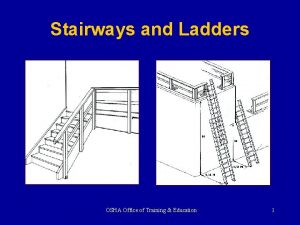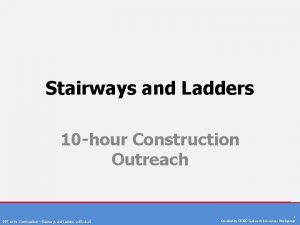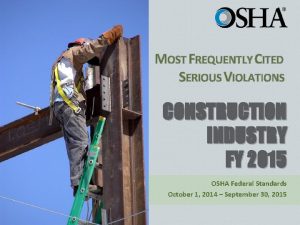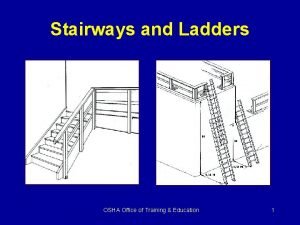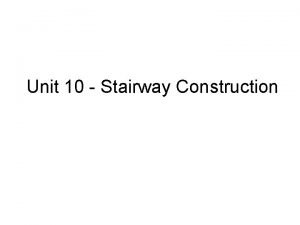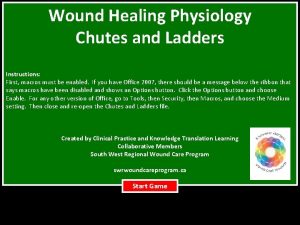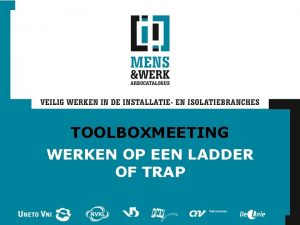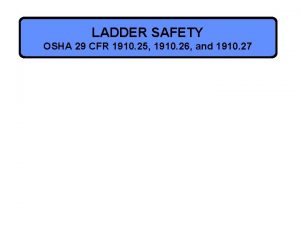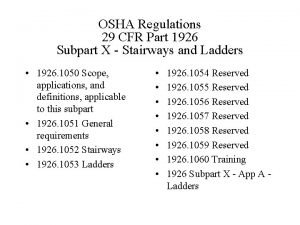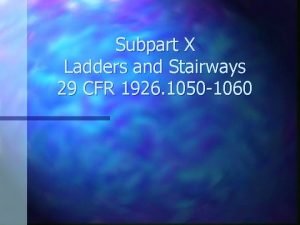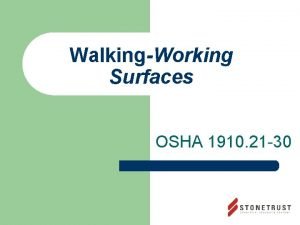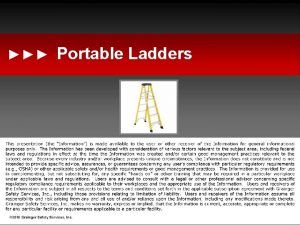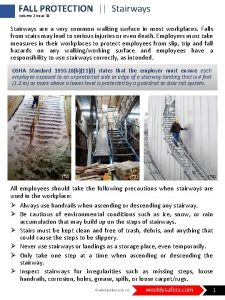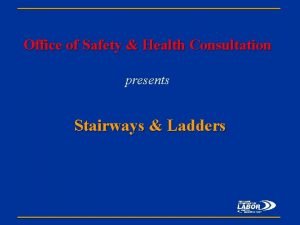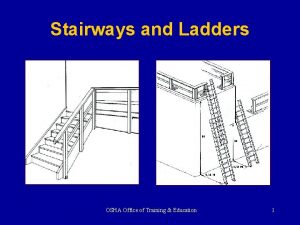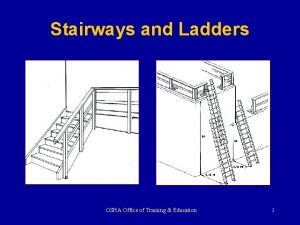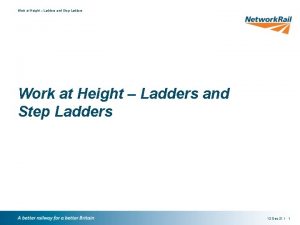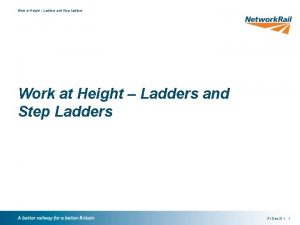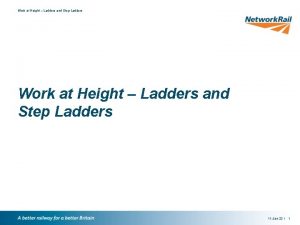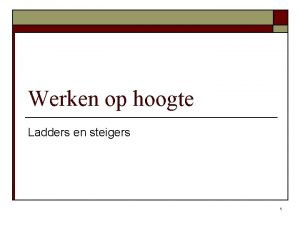Stairways and Ladders June 2009 Field Health and


















- Slides: 18

Stairways and Ladders June 2009 Field Health and Safety Training 1

Introduction l l Stairways and ladders are a major source of injuries and fatalities among construction workers. 24, 882 injuries and 36 fatalities per year June 2009 Field Health and Safety Training 2

General Requirements l l stairway or ladder must be provided at all worker points of access where there is a break in elevation of 19 inches or more… when there is only one point of access between levels, it must be kept clear to permit free passage… June 2009 Field Health and Safety Training 3

General Requirements l l when there are more than two points of access between levels, at least one point of access must be kept clear all stairway and ladder fall protection systems required must be installed June 2009 Field Health and Safety Training 4

Stairways l Requirements for all stairways used during construction • See text l Requirements for stairs in temporary service during construction • See text June 2009 Field Health and Safety Training 5

Stairrails and Handrails l l l stairways having four or more risers or using more than 30 inches in height must have at least one handrail and installed on the unprotected edge winding or spiral stairways must be equipped with a handrail stairrails, installed after 15 March 1991, must be at least 36 inches in height June 2009 Field Health and Safety Training 6

Stairrails and Handrails l l l midrails screens or mesh intermediate vertical members June 2009 Field Health and Safety Training 7

Stairrails and Handrails l handrails and the top rails must be capable of withstanding, without failure, at least 2, 000 pounds (890 n) of weight applied within two inches of the top edge in any downward or outward direction at any point along the top edge June 2009 Field Health and Safety Training 8

Stairrails and Handrails l l l height of the top edge of a handrail must be be more than 37 inches nor less than 36 inches… stairrail and handrails must be surfaced to prevent injuries… handrails must provide an adequate handhold for employees to grasp… June 2009 Field Health and Safety Training 9

Stairrails and Handrails l l l constructed to prevent dangerous projections… temporary handrails must have a minimum clearance of 3 inches between the handrail and walls… unprotected sides and edges of stairway landings must be provided with standard 42 inch guardrail systems June 2009 Field Health and Safety Training 10

Ladders l General requirements apply to all ladders including job-made ladders • See text June 2009 Field Health and Safety Training 11

Portable Ladders l l l Must support at least four times the maximum intended load Minimum clear distance between side rails for all portable ladders must be 11. 5 inches Rungs and steps must be corrugated, knurled, dimpled or coated with skid-resistant materials June 2009 Field Health and Safety Training 12

Fixed Ladders (see text) l Cages for fixed ladders • See text l Wells for fixed ladders • See text June 2009 Field Health and Safety Training 13

Ladders: Structural Defects l l Broken or missing rungs Corroded components Split rails Ladder repairs must restore the ladder to a condition meeting its original design criteria June 2009 Field Health and Safety Training 14

Ladders: Training Requirements l l Nature of fall hazards in the work area Correct procedures for erecting, maintaining, and disassembling the fall protection systems to be used Proper construction, use, placement, and care in handling of all stairways and ladders Maximum intended load-carrying capacities of ladders used June 2009 Field Health and Safety Training 15

Scaffolds 1926. 451 June 2009 Field Health and Safety Training 16

Scaffold Safety Requirements l l l l Footing or anchorage must be sound Support at least four times maximum load intended Maintained Immediately repaired Safe means to access Overhead protection Guardrails, midrails, toeboards Do not work in storms or wind, ice or snow June 2009 Field Health and Safety Training 17

June 2009 Field Health and Safety Training 18
 A double cleated ladder
A double cleated ladder Double-cleated ladder
Double-cleated ladder A commonly cited hazard for stairways and/or ladders is
A commonly cited hazard for stairways and/or ladders is A commonly cited hazard for stairways and or ladders is
A commonly cited hazard for stairways and or ladders is Stairways and ladders osha
Stairways and ladders osha How to calculate staircase
How to calculate staircase Chutes and ladders instructions
Chutes and ladders instructions Who invented snakes and ladders
Who invented snakes and ladders Vca werken op trap
Vca werken op trap 1926 ladders
1926 ladders Osha 1910 ladders
Osha 1910 ladders Osha 1910 ladders
Osha 1910 ladders Osha handrail requirements 1926
Osha handrail requirements 1926 Ladders to literacy
Ladders to literacy 1926 ladders
1926 ladders Two extension ladders are leaning at the same angle
Two extension ladders are leaning at the same angle Osha housekeeping 1910
Osha housekeeping 1910 The three main types of portable ladders are
The three main types of portable ladders are Gauss law of magnetism
Gauss law of magnetism
